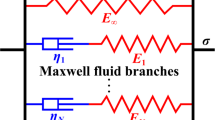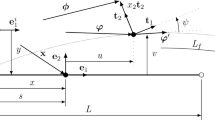Abstract
This paper addresses the problem of reducing the constitutive behavior of relatively complex mechanical systems to lumped deformable components that connect two nodes of a multibody system. It is common practice, both in finite element and multibody system dynamics analysis, to refer the constitutive properties of lumped components to one of the nodes they connect. It is shown that this practice, here termed “attached,” could result in either underestimating or overestimating the couplings related to the finiteness of the relative rotation between the connected nodes. This work proposes an alternative formulation, here termed “intrinsic” that allows to correlate very well the behavior of general lumped deformable components with that resulting from the nonlinear finite element analysis of three-dimensional models of the components. Numerical examples, including the analysis of components that are widely used in the mechanical and aerospace industry, show how the proposed formulation can easily and accurately account for nonlinear geometrical effects, and thus deliver compact and accurate models suitable for the analysis of the global behavior of rather complex components.
Similar content being viewed by others
References
Shabana, A.A.: Dynamics of Multibody Systems, 2nd edn. Cambridge University Press, Cambridge (1998)
Schiehlen, W.: Multibody system dynamics: Roots and perspectives. Multibody Syst. Dyn. 1(2), 149–188 (1997). doi:10.1023/A:1009745432698
Shabana, A.A.: Flexible multibody dynamics: Review of past and recent developments. Multibody Syst. Dyn. 1(2), 189–222 (1997). doi:10.1023/A:1009773505418
Wasfy, T.M., Noor, A.K.: Computational strategies for flexible multibody systems. Appl. Mech. Rev. 56(6), 553–613 (2003). doi:10.1115/1.1590354
Pan, W., Haug, E.J.: Dynamic simulation of general flexible multibody systems. Mech. Based Des. Struct. Mach. 27(2), 217–251 (1999). doi:10.1080/08905459908915697
Wallrapp, O., Schwertassek, R.: Representation of geometric stiffening in multibody system simulation. Int. J. Numer. Methods Eng. 32, 1833–1850 (1991). doi:10.1002/nme.1620320818
Ambrósio, J.A.C.: Dynamics of structures undergoing gross motion and nonlinear deformations: A multibody approach. Comput. Struct. 59(6), 1001–1012 (1996). doi:10.1016/0045-7949(95)00349-5
Géradin, M., Cardona, A.: Flexible Multibody Dynamics: a Finite Element Approach. Wiley, Chichester (2001)
Shabana, A.A., Schwertassek, R.: Equivalence of the floating frame of reference approach and finite element formulations. Int. J. Non-Linear Mech. 33(3), 417–432 (1998). doi:10.1016/S0020-7462(97)00024-3
Ledesma, R., Ma, Z.-D., Hulbert, G., Wineman, A.: A nonlinear viscoelastic bushing element in multibody dynamics. Comput. Mech. 17(5), 287–296 (1996). doi:10.1007/BF00368551
Kadlowec, J., Wineman, A., Hulbert, G.: Elastomer bushing response: experiments and finite element modeling. Acta Mech. 163, 25–38 (2003). doi:10.1007/s00707-003-1018-1
MSC/ADAMS User’s Manual, 2007
Abaqus Theory Manual, Abaqus Version 6.7 edition
Merel, J., Wander, I., Masarati, P., Morandini, M.: Analysis of load patterns in rubber components for vehicles. In: Multibody Dynamics 2007, ECCOMAS Thematic Conference, pp. 1–19, Milan, June 25–28, 2007
Pfister, F.: Bernoulli numbers and rotational kinematics. J. Appl. Mech. 65(3), 758–763 (1998). doi:10.1115/1.2789120
Betsch, P., Menzel, A., Stein, E.: On the parametrization of finite rotations in computational mechanics. A classification of concepts with application to smooth shells. Comput. Methods Appl. Mech. Eng. 155(3–4), 273–305 (1998). doi:10.1016/S0045-7825(97)00158-8
Bauchau, O.A., Trainelli, L.: The vectorial parameterization of rotation. Nonlinear Dyn. 32(1), 71–92 (2003). doi:10.1023/A:1024265401576
Borri, M., Trainelli, L., Bottasso, C.L.: On representations and parameterizations of motion. Multibody Syst. Dyn. 4(2–3), 129–193 (2000). doi:10.1023/A:1009830626597
Merlini, T., Morandini, M.: The helicoidal modeling in computational finite elasticity. part II: multiplicative interpolation. Int. J. Solids Struct. 41(18–19), 5383–5409 (2004). doi:10.1016/j.ijsolstr.2004.02.026
Shoemake, K.: Animating rotation with quaternion curves. SIGGRAPH Comput. Graph. 19(3), 245–254 (1985)
Borri, M., Bottasso, C.L.: An intrinsic beam model based on a helicoidal approximation—part I: Formulation. Intl. J. Numer. Methods Eng. 37, 2267–2289 (1994). doi:10.1002/nme.1620371308
Jelenić, G., Crisfield, M.A.: Geometrically exact 3D beam theory: implementation of a strain-invariant finite element for statics and dynamics. Comput. Methods Appl. Mech. Eng. 171, 141–171 (1999)
Krenk, S.: A vector format for conservative time integration of rotations. In: Multibody Dynamics 2007, ECCOMAS Thematic Conference, pp. 1–12, Milan, June 25–28, 2007
Cardona, A., Geradin, M.: A beam finite element non-linear theory with finite rotations. Int. J. Numer. Methods Eng. 26, 2403–2438 (1988)
MBDyn Input Manual (Version 1.3) (2007)
Merlini, T.: Recursive representation of orthonormal tensors. DIA-SR 03-02, Dip. Ing. Aerospaziale, Politecnico di Milano (2003)
MBDyn Technical Manual (Version 1.3) (2007)
Trainelli, L.: On the parameterization of rotation and rigid motion: a comprehensive picture. In: 17th Congresso nazionale AIDAA, pp. 1349–1362, Rome, Italy, September 15–19, 2003
Author information
Authors and Affiliations
Corresponding author
Rights and permissions
About this article
Cite this article
Masarati, P., Morandini, M. Intrinsic deformable joints. Multibody Syst Dyn 23, 361–386 (2010). https://doi.org/10.1007/s11044-010-9194-y
Received:
Accepted:
Published:
Issue Date:
DOI: https://doi.org/10.1007/s11044-010-9194-y




